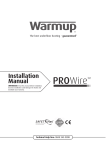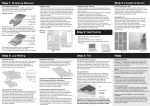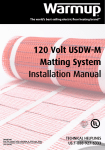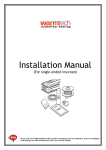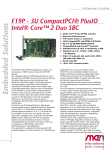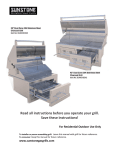Download Underfloor Heating Cable Installation Manual
Transcript
Affordable Underfloor Heating Underfloor Heating Cable Installation Manual Technical Helpline 0845 034 8272 Before You Begin Installation... Compatible floor finishes The SunStone heater is intended to warm stone or tile floors. The Right Measurements You should have the correct room dimensions, size and number of heaters for the job. Note that a cut heating cable cannot be returned. Heater Length Code Area covered Wattage @ 230Vac SSW300 SSW450 SSW600 SSW750 2 3 4 5 300W 450W 600W 750W 25.5m 38.0m 51.0m 63.5m sqm sqm sqm sqm Amperage @ 230Vac 1.30A 1.96A 2.61A 3.26A The Necessary Tools This box includes a heating cable, fixing tape, primer and roller. Also required: - THERMOSTAT WITH FLOOR SENSOR - RCD as required for all installations - Multi-meter for testing the resistance of the wires - Electrical housing for connection leads, junction boxes and 35mm deep back box for the thermostat - Permanent marker, measuring tape and scissors for the tape Electrics As all electrical work must comply with the current IEE Wiring Regulations, we strongly recommend that you do not take on any electrical work unless qualified to do so. General Precautions What To Do What Not To Do Plan the heater layout and installation so that any drilling after tiling (eg for fixing sanitary ware) will not damage the wiring. Cut or shorten the heating wire ever Use flexible ceramic tile adhesives and grouts suitable for use with undertile heating Store tiles or other sharp or heavy objects on the heaters while tiling Walk over an installed heater as this can cause damage Install the heating up walls or up a set of stairs Wait at least 10 days for the tile adhesive to dry before switching the system on for the first time Install heating wires under units with solid bases or built-in furniture Only connect the heating wires in parallel and maintain consistent spacing Overlap heaters in case of overheating Position the floor sensor or power lead on or beneath the heating element Test the system before, during and after installation 2 About The SunStone Heater Floor Sensor: For the thermostat and heating system to work properly, installation must be correct. Before embedding in adhesive, position the sensor at least 150mm into the heated area, exactly between two runs of heating element. Keep the sensor tip away from drafts, sunlight, radiators, hot water pipes or other sources of heat fluctuations. Wire Composition: Element Core Insulation Metallic Earth Braid Heater Layout: PVC Insulation Floor Sensor Joint Power Lead (to thermostat) Evenly spaced Heating Wire Sticky Tape keeps wire in place The joint which connects the heater wire and power lead must be installed under the tiles. It may be necessary to cut a small groove in the subfloor to allow for the extra thickness of the power lead and floor sensor. Adapting the heater to room shapes The heater is flexible enough to follow the shapes of units, so that the maximum area of coverage is achieved. Take care not to damage the wire in any way. If you believe you have cut the wire, call the helpline immediately. REMEMBER! If you have any question regarding the installation of your heater, please call the helpline on 0845 034 8272. 3 Electrics RCD Requirement A dedicated 30mA RCD is compulsory and each thermostat must be protected by a fused spur. Combination RCD/fused spurs should be used if the electrical circuits are not protected by a RCD. It is possible to run the heater(s) from an existing circuit but check with an electrician if the circuit is RCD protected and can handle the load. Electrical housing A 35-40mm deep backbox is required for the thermostat and if more than two heaters are being installed, a junction box will also be needed. The wiring from the heater to the thermostat should be chased into the wall and protected by conduit or plastic trunking. Thermostat connection To install, follow the instructions in the thermostat box. Connect the thermostat to the main electrical supply via a fuse or circuit breaker according to wiring regulations. The thermostat should be installed within the room or area to be heated, except where electrical regulations prohibit eg. within the bathroom itself. In such cases, the thermostat should be fitted to the outside of an internal wall of the bathroom, as near to the heating power supply wires as possible. Wiring Overview: Mains Power Fused Spur / RCD Thermostat 3-core cable Junction Box Power Leads Floor Probe Heating Cable= 4 Heating Cable= Checking Resistances Check the resistances of your heater AT LEAST THREE TIMES during the installation process to ensure that it is working. This is best done before installation work begins, while fixing the heater and just before tiling. BEFORE INSTALLING DURING INSTALLATION AFTER INSTALLING Check the resistance of each heater in case damage had occurred during the freight. Note the resistances in the table provided below. When each heater has been fixed to the subfloor, test again for damage occurred during installation. To check that no damage has been done during the setting of the tiles, test once more after the floor covering has been put down. If you are unsure of your readings or think that there is a problem, call the helpline right away on 0845 034 8272. How to test with a multi-meter We recommend the use of a digital multi-meter set to a range of 0-2k ohms for testing the heaters and 20k -200k for testing the floor sensor. Please note that due to the high resistance of the wire, it may not be possible to get a continuity reading and for this reason, continuity testers are not recommended. The resistance (ohms) of each heater should be measured from the live (brown) wire to the neutral (blue) wire. Jot down the readings you get from the multi-meter in the blank chart provided below. The readings should be within +/- 5% of these measurements: resistances in the table below. Heater size (sqm) 300450600750 ohms 176.9117.388.1 70.6 Results of Your Tests Heater No. Size of Heater “Proper” Reading Reading (No.1) Reading (No.2) Reading (No.3) 5 Preparations SUBFLOORS Follow these techniques for your subfloor type to ensure a rigid base. Then on a clean, dust and grease-free floor, paint with the primer. Allow to dry for 3 hours; the colour should change from light to dark green when dry. Do not prime on insulated tile backer board or existing ceramic/ quarry tiles. Wooden Subfloors Allow sufficient underfloor ventilation. Pre-levelling existing floorboards with a latex/cement self-levelling compound will give a flush, secure fit for the subsequently applied WBP plywood. Seal the backs and edges of the plywood according to BS 5385:Part 3. clause 14.4. To achieve a floor stable enough for accepting tiles, fit tongue and groove flooring and then overboard with ply or tile backer board. The above recommendations apply to small floor areas as advised in clause 14.4 of BS 5385: Part 3:2007. Concrete Subfloors Extruded polystyrene tile backer boards with cement-based facing yield the best results. Follow manufacturer’s instructions for fixing. Once the board is attached to the subfloor, the heating system may be laid right on top of the board, and then tiled over. Use high-quality, cement-based flexible tile adhesive and grout. HEATER LAYOUT 1. Show key locations on subfloor with permanent marker • • • Designated spots of units and fixtures. Do not install the heater in any of these areas. Positions of the power lead cables and the floor sensor. Points where the wires will need to be turned when laid. Please refer to page 8 for possible layouts and wire spacings. 2. Mark a start point Mark up a start point as close as possible to the power supply, but no further than 2.5m from it. 3. Check resistances Perform test #1 for each heater as explained in this manual. 4. Dry fit the heater(s) Lay the wires out according to your plan so you can still make any last minute adjustments in the layout before fixing them. Avoid stepping on or kinking the heater to prevent wire fracture. Time Allowance After installation, you must allow the tile adhesive and any self-levelling used to cure naturally before powering-up the heating system. This takes 10-14 days depending on the amount of materials used. Failure to await the correct length of time may result in damage to the system and may also cause the adhesive and grout to dry too quickly, hence becoming brittle, leading to tiles lifting and/or cracking. 6 Installations Heater Installation 1. Fit the Heater(s) Starting at the point where the power supply cable joins the heating wire, gently unreel the cable and lay wire out around the perimeter. Only lay the wires in parallel lines. Note : Ensure that all of the heating element including the joints are covered in adhesive and tiled over. Do not tape over the joints as this will create air pockets. 2. Install Floor Sensor The floor sensor that comes with the thermostat should now be placed centred between two runs of heating elements and secured in place using double-sided tape. Now check the resistance of the floor sensor using your multi-meter. You may need to change the setting on your meter in order to accommodate for the higher readings. If you do not get a reading, your sensor may be damaged. If so, call the helpline for a replacement. 3. Fit the Power Leads Each heater has a single power lead for connecting the system to the thermostat. To keep the power leads at the same height as the heating element, a channel can be created in the subfloor. Take care not to damage the heating wire. Tape the leads in place. 4. Install Thermostat Instructions for fitting the thermostat can be found in the thermostat box. 5. Check resistances again Perform test #2 for each heater as explained on page 5. Tiling When all your heaters are installed and the power leads and floor sensor have been fixed, begin laying your tiles using one of two methods: One-Step Method: Apply a thick layer (5-10mm) of tile adhesive directly onto the heaters and lay the tiles onto the adhesive layer. Dual-Step Method: 1. Completely cover the heating wires with a smooth layer of flexible adhesive or latex selflevelling compound and allow to dry; it will normally take 1 day per mm. 2. Apply a thin layer (3mm) of flexible adhesive and tile as normal. To • • • • decide on which method, consider the following: It is easier to lay mosaic tiles using the dual-step method If this is your first installation, you may find it easier to use the dual-step method If the floor will not be tiled right away, the dual-step method offers better wire protection The one-step method is usually used by experienced installers of this heating system Check final resistances Perform test #3 for each heater as explained in this manual. 7 Positioning the Heater Use the example guides below to work out where the wires are to be placed. The wires must only be used in the lengths supplied and must not be cut or joined. When laying more than one heater, do not allow the heating wires to touch or cross. Only join heaters in parallel, NOT in series. For best efficiency, space the wires equally (refer to spacing guide below). Two or More Heaters in Room with Fixtures Single Heater in Regular Room Use the following calculation to work out the cable spacing. Floor Area (m²) x 1000 ______________ Length of heater cable = wire Spacing Heater Spacing Guide Area (m²) Spacing (mm) 75 100 90 110 100 110 100 110 1.5 2.0 2.5 3.0 3.5 4.0 4.5 5.0 Always allow at least 50mm between wires at all times and at least 40mm between wires and walls. 8 Heater Layout 9 Product Warranty ...................................................................................................................... YOUR STATUTORY RIGHTS WILL REMAIN UNAFFECTED BY THIS WARRANTY. This SunStone undertile heater is guaranteed against any manufacturing defect for 10 years starting from date of purchase. This warranty covers the cost of replacement or repair of the SunStone undertile heater only, subject to the discretion of the manufacturer. This is the sole warranty, express or implied. The manufacturer or its agents cannot be held liable for any resultant damages. Send the completed form back to: SunStone Warranty, BCR House, 3 Bredbury Business Park, Stockport, SK62SN Proof of purchase is needed in the event of a claim, so keep your invoice with this warranty This warranty is subject to the following conditions: 1. This warranty must be registered. 2. The heater must have been installed and used in full accordance with the installation manual. 3. The heater must have been earthed and protected by an RCD at all times. 4. The heater is used in conjunction with a thermostat or control system approved by SunStone. 5. The warranty is returned to SunStone within 30 days of purchase of the heater(s). 7. If SunStone or its agents carry out diagnostic or remedial work as a result of a claim being made, agents shall have the right to levy reasonable charges for the work undertaken by them. 8. All electrical regulations are complied with and electrical work is undertaken by a qualified and Part P certified electrician. This warranty does not cover heater failure due to incorrect installation or tiling. Please check that the heater is working (as laid out in the installation manual) prior to tiling. Name Address Postcode Telephone Email Installer Electrician Date of purchase Room the heating system is installed: Subfloor type (Concrete/Wood etc): Signed: Date: Project in Brief Place this card in a visible spot close to the consumer unit. Please Note: 1. A 30mA RCD must be used in conjunction with the heating system. 2. Never cut or shorten the heating element 3. Ensure all parts of the heating element (including joints) are installed beneath the tiles. 4. For the guarantee to be valid, this form must be completed. 5. Check that the values match the ones in the instruction manual. 6. Draw a plan showing the layout of the heater Warning! – Risk of electric shock - Electric wiring and heating panels contained below the floor. - Do not penetrate with nails, screws, or similar devices. - Do not restrict the thermal emission of the heated floor. Heater Location Resistance Value Attach label with heater description here Before Installation: _____________ohms After Installation: _____________ohms Signature Date Electrician’s Part P registration no. Company stamp/name Affordable Underfloor Heating SunStone Underfloor Heating Tel: 0845 034 8272 v1.0 05/12












